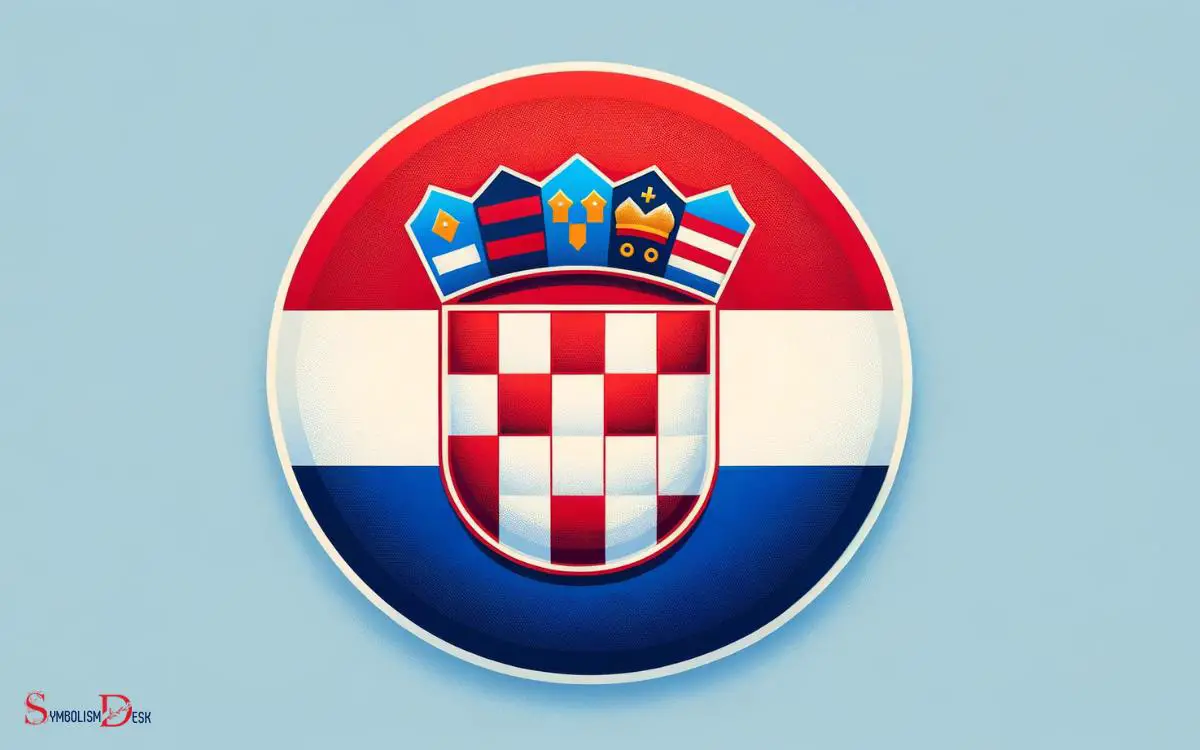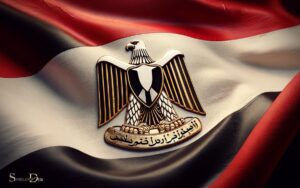What Do the Symbols on the Croatian Flag Mean? Explain!
The Croatian flag consists of three equal size, horizontal stripes in colors red, white, and blue, from top to bottom.
In the middle, it features the Croatian coat of arms which represents the five historical regions of Croatia, including Croatia proper, Dubrovnik, Dalmatia, Istria, and Slavonia.
The Croatian flag is a tricolor consisting of three bands of equal width. The top stripe is red, the middle one is white and the lowest stripe is blue.
These colors are Pan-Slavic, meaning they are commonly used among Slavic nations. The shield in the middle of the flag represents the Croatian coat of arms, which is a checkerboard that alternates red and white squares.
Inside this shield, there are five smaller shields that represent the historical regions of Croatia, each having their unique symbols.

Key Takeaway
3 Symbols and Meanings of the Croatian Flag
| Symbol | Meaning |
|---|---|
| Red-White-Blue Stripes | The three horizontal stripes represent the three historical regions of Croatia: Red for Croatia, blue for Slavonia, and white for Dalmatia |
| Croatian Coat of Arms | The featured checkerboard shield (also known as “šahovnica”) has been the symbol of Croatian kings since at least the 10th century |
| The Five Crowning Shields | They symbolize the five historical regions of Croatia. The first shield represents the oldest known coat of arms of Croatia, the second represents Dubrovnik, the third represents Dalmatia, the fourth represents Istria, and the fifth represents Slavonia |
Historical Origins of the Croatian Flag
The historical origins of the Croatian flag can be traced back to the medieval kingdom of Croatia. The flag consists of three horizontal stripes of red, white, and blue, arranged in that order from top to bottom.
The red and white checks, known as the ‘chequy’ or ‘šahovnica,’ have been associated with Croatia since the Middle Ages. These checks are traditionally linked to the coat of arms of the medieval Kingdom of Croatia, which featured a red and white pattern.
The addition of the blue stripe was a result of the union between Croatia, Slavonia, and Dalmatia in the 19th century. This historical flag has evolved through centuries, reflecting the nation’s journey and embodying the rich heritage and unity of the Croatian people.
Symbolism of the Red, White, and Blue Colors
Representing the nation’s history and unity, the red, white, and blue colors on the Croatian flag hold significant symbolism. The red, white, and blue have been associated with Croatia for centuries.
The red symbolizes the blood shed for the country, as well as the vitality and courage of the Croatian people. The white represents peace and the enduring commitment to morality and righteousness. Finally, the blue is associated with the country’s resilience and determination.
These colors not only reflect the historical struggles and triumphs of the Croatian people but also embody the values of freedom, peace, and patriotism.
The combination of these colors on the flag serves as a powerful visual representation of the Croatian identity and a reminder of the nation’s enduring spirit.
Meaning and Significance of the Coat of Arms
The Coat of Arms on the Croatian flag, known as the ‘Croatian chequy’, holds deep historical and cultural significance for the nation. The checkerboard pattern consists of 13 red and 12 silver (white) fields, representing the traditional regions of Croatia.
The red and white colors are also associated with Croatia’s coat of arms, emphasizing the importance of this symbol in Croatian history and identity.
The crown above the chequy symbolizes the sovereignty of Croatia, highlighting the country’s independent and royal heritage. The five smaller shields within the crown represent the historical regions of Croatia.
This rich symbolism reflects the unity and diversity of the Croatian people and their enduring pride in their heritage.
| Symbol | Meaning |
|---|---|
| Checkerboard pattern | Represents the traditional regions of Croatia |
| Red and white colors | Symbolize Croatia’s coat of arms |
| Crown | Signifies the sovereignty of Croatia |
Evolution of the Croatian Flag Design
An essential aspect to consider when exploring the evolution of the Croatian flag design is the historical significance of the checkerboard pattern and its enduring representation of the traditional regions of Croatia.
The evolution of the Croatian flag design can be traced through its various iterations, each reflecting the country’s historical and political developments.
Three key points to consider are:
- Historical Influence: The evolution of the Croatian flag design has been influenced by the country’s rich history, including periods of independence and foreign rule, which have left their mark on the flag’s symbolism and design.
- Political Changes: Over time, the Croatian flag has evolved in response to political changes, such as the transition from a socialist republic to an independent state, leading to alterations in its design and symbolism.
- Cultural Continuity: Despite the changes in design, the checkerboard pattern has remained a constant symbol, reflecting the enduring cultural and historical significance of Croatia’s traditional regions.
This evolution emphasizes the deep-rooted significance of the Croatian flag and its ability to encapsulate the country’s history and identity.
Do the Symbols on the Croatian Flag Also Represent National Identity, like the Maple Leaf on the Canadian Flag?
The symbols on the canadian flag, notably the iconic maple leaf, have come to symbolize the country’s national identity. Similarly, the symbols on the Croatian flag, including the coat of arms featuring a checkerboard pattern, also hold significant meaning and represent the country’s rich cultural heritage. Each flag serves as a powerful visual representation of the respective nation’s identity and values.
Are the Symbols on the Russian Flag Similar to Those on the Croatian Flag?
The meaning of Russian flag symbol and the symbols on the Croatian flag are not similar. The Russian flag consists of three horizontal stripes, while the Croatian flag is made up of three horizontal stripes as well, with the addition of the country’s coat of arms located in the center. Each flag represents the unique history and heritage of its respective country.
Cultural and National Identity Reflected in the Flag
Reflecting the enduring cultural and historical significance of Croatia’s traditional regions, the symbols on the Croatian flag hold deep-rooted meaning that speaks to the country’s cultural and national identity.
The red, white, and blue colors symbolize Croatia’s ties to the Pan-Slavic movement, with the red-white checkerboard shield, known as the “chequy,” representing Croatia’s rich history, dating back to the medieval Kingdom of Croatia.
The 25 red and white alternating fields in the shield pay homage to the historic regions of Croatia, while the five crowns within the chequy symbolize the historical regions of Croatia.
The significance of these symbols showcases Croatia’s cultural and national identity, representing its historical legacy and unifying the country under a common identity.
| Symbol | Meaning | Significance |
|---|---|---|
| Red, White, Blue | Ties to the Pan-Slavic movement | Represents Croatia’s connection to Slavic roots |
| Chequy | Represents Croatia’s rich medieval history and the medieval Kingdom of Croatia | Symbolizes Croatia’s historical legacy |
| 25 Fields, 5 Crowns | Homage to the historic regions of Croatia and the historical regions of Croatia | Unifies the country under a common identity |
Conclusion
In conclusion, the symbols on the Croatian flag hold historical, cultural, and national significance.
The red, white, and blue colors represent valor, peace, and independence, while the coat of arms reflects the country’s historical ties and identity.
The evolution of the flag design mirrors Croatia’s journey as a nation. Overall, the Croatian flag is a powerful embodiment of the country’s cultural heritage and national pride.







